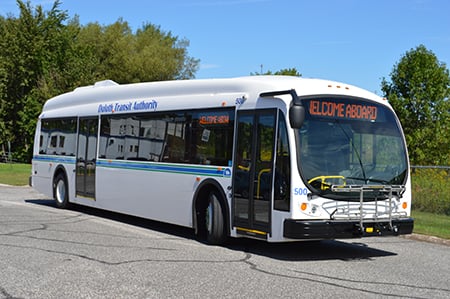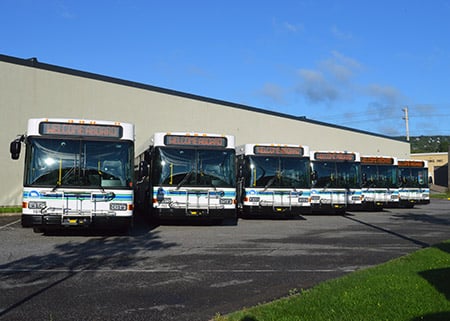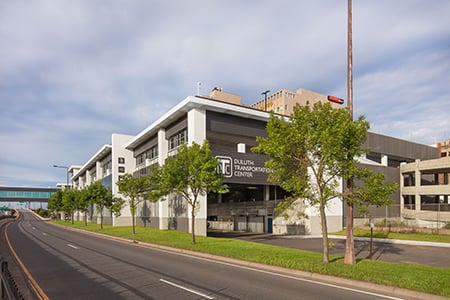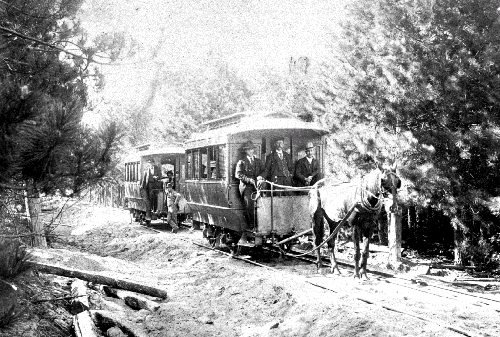Our Mission
The DTA mission is to provide a public transit service that is safe, convenient, efficient and affordable.
Service Hours of Operation
M-F | 4:00AM – 12:00AM
SAT | 5:00AM – 12:00AM
SUN | 5:00AM – 12:00AM
Quick Facts About The DTA
General Information
- 150 Employees
- Service Area – Duluth, Superior, Proctor and Hermantown
- More than 100 bus shelters
- Approximately 1,700 bus stops
Fixed-Route Service
- 7 Electric Buses
- 6 Hybrid Buses
- 57 Diesel Buses
- 3 Trolley Buses
- 2018 Operating Budget: $17,667,149
- 2018 Ridership: 2,760,475
Paratransit Service
- 12 Vehicles
- 2018 Operating Budget: $983,036
- 2018 Ridership: 34,311
Facilities
- Operating Center (2402 West Michigan Street) – opened 1981
- Duluth Transportation Center (DTC – 228 West Michigan Street) – opened 2016
- Kirby Plaza Transit Hub
- Miller Hill Mall Transit Hub
- One Park & Ride Lot
Leadership Team
Rod Fournier
General Manager
Nancy Brown
Director of Administration
Chris Belden
Director of Planning & Grants
Nene Israel
Director of Finance
Mark Ness
Director of Maintenance
David Clark
Director of Marketing
Jeffrey Dahlgren
Director of Operations
Aleda Johnson
Director of Information Technology
Michael Ahlin
Director of Safety and Security
Nick Ackman
Director of Scheduling
CONTACT DTA LEADERSHIP
Sustainability
Think Green…Ride the Bus!
At DTA, we’ve taken a number of steps to reduce our carbon footprint. From hybrid buses to using LED lights in our interiors, we are committed to providing a sustainable service for our community.
Electric Buses
Leading the Charge with NEW Electric Buses!
- 440 kWh (kilowatt hour) of battery power
- Range of up to 200 miles on a fully-charged battery
- Full-charge time is 2-5 hours (done at the DTA Operating Center)
- Regenerative braking system charges batteries when brakes applied
- Exclusive diesel-fueled auxillary heater with about 100,000 additional Btu
- Single 220 kW (kilowatt) motor with 2-speed automatic transmission
- Carbon fiber (less than 50%) reinforced composite body structure
- 40-seat capacity (two more than a standard diesel bus)
- Vehicle kneels and is fully ADA-accessible with a ramp and wide aisles
- Made in the U.S.A. at a factory in Greenville, South Carolina
Hybrid Buses
What is a hybrid bus?
Hybrid bus motors act like generators. When a hybrid bus brakes, the energy created is stored and is then used to accelerate. Forty percent of the energy to accelerate the bus is actually energy saved during the braking process.
What is a hybrid bus?
- Run smoother and quieter than conventional buses
- Use electric power until they reach 10 mph
- Are equipped with 5.9 liter 6-cylinder, clean-burning diesel engines
- Get 33 percent better fuel economy than standard buses
- Produce 90 percent fewer emissions than the buses they replace
Other DTA Sustainability Efforts:
- Solar panels on the DTC generate electricity to help offset the cost for lighting the facility
- LED lighting with motion sensors are replacing older T-12 florescent fixtures at the Operating Center
- Lighting improvements have reduced the DTA’s monthly electric bills by more than 40 percent
- Efficient heating replaced natural gas boilers for a 75% reduction in heating costs and over 1,300 less gallons of glycol used
- The DTA’s fleet primarily consists of diesel and electric-hybrid buses; advances in engine technology have increased fuel efficiency
- Clean, low-sulfur diesel fuel and soy based fuel helps decrease carbon emissions
























